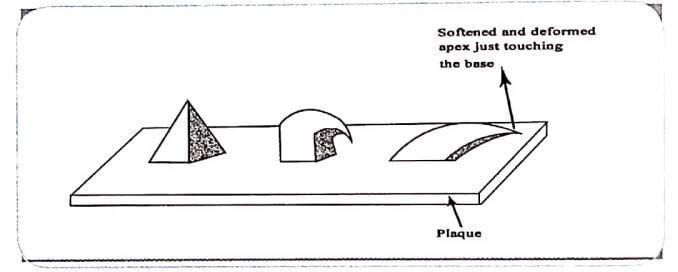Properties of refractories depend mainly on their chemical composition, grain size and method of fabrication.
Refractoriness:
It is the capacity of the material to withstand the heat without appreciable deformation.
-
It is measured as the softening temperature of refractory materials. This softening temperature is determined by using ‘pyrometric cone test’. Pyrometric cones act as a heat work recorder.
-
Pyrometric cones are also known as seger cones.
-
Refractoriness is determined by comparing the behaviour of the cone material to be tested with that of a series of seger cones of standard dimensions.
-
The refractoriness is expressed in terms of pyrometric cone equivalent (PCE).
-
These cones are small pyramid shaped, 38 mm high and have a triangular base with 19 mm long sides.
-
They melt or fuse at definite temperatures when heated under standard condition of 10°C/min.
-
The temperature range of fusion of the tested cone is indicated by its apex touching the base.
-
The pyrometric cone equivalent (PCE) value at the given temperature of the refractory is taken as the number of the standard cone which fuses along with the test cone.

Fig (1) Seger cone – test
Refractoriness under load (RUL):
The load bearing capacity of the material is measured by means of RUL test.
-
A refractory material should also possess high mechanical strength, even at operating temperatures, so that it may bear maximum possible load without breaking.
-
RUL is generally performed by applying a constant load of 1.75 kg/cm2 to a specimen of refractory. Heating is carried out in a carbon resistance furnace at a rate of 10°C/min.
-
RUL is a temperature at which 10% deformation in the refractory occurs.
Fusion point:
Fusion point is the temperature at which the refractory starts to soften.
- The refractories must be able to withstand high temperature. They must remain unaffected at the temperature at which the chemical process is being carried out.
- Fusion point, acts as an index of its suitability for a particular process at a given temperature.
- The fusion temperature of the refractories normally ranges from 1600 to 2700°C.
- Fusion points are determined by using pyrometric cones.
Porosity :
Porosity of a refractory material is given by the ratio of its pores volume to that of its bulk volume.
- All refractories contain pores. It is calculated as
Porosity (P)=(W−D/W−A)×100
where, W = weight of a saturated specimen (with water) in air, D= weight of dry specimen in air and A= weight of saturated specimen (with water) in water.
-
Porosity is directly related to many other physical properties of brick including resistance to chemical attack.
-
The greater the porosity of the brick, the more easily it is penetrated by molten fluxes and gases.
-
The brick with the lowest porosity has the greatest strength, thermal conductivity and heat capacity.
Spalling:
Spalling is cracking and flacking or fracture of a refractory.
-
This is caused by the uneven expansion of a refractory due to heat.
-
Refractories usually expand when they are heated. They normally undergo flaking or disintegration, when they are subjected into rapid heating or cooling.
-
Refractories should be able to withstand spalling.
-
Spalling of refractories can be decreased to a greater extent by properly firing the refractory.
-
The spalling may be due to thermal agitations, mechanical causes or structural factors etc.
Strength:
Strength is the resistance of the refractory to loads, tension and shear stresses in cold as well as at hot working conditions.
- They must also be able to withstand abrasion or erosion of the furnace charge and also pressure of the load.
- The strengths of refractories are different for different refractories.
Thermal conductivity:
- This is probably due to the absence of air in voids.
- Conductivity curves are helpful in the selection of refractory for a specific purpose to be served at a particular temperature.
- The conductivity of different refractories is not the same. For example, ordinary furnace block should have low thermal conductivity. But certain constructions like muffles, by-product oven walls and recuperators etc., require high thermal conductivity refractories.
| Read More Topics |
| Classification of nuclear reactor |
| light water reactor nuclear power plant |
| What is the basic theory of chemical kinetics? |





